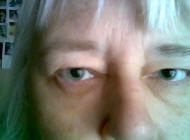How to Perform a Head to Toe Assessment
This article describes the basics of a head-to-toe assessment. This is a vital aspect of nursing. It should be done each time you encounter a patient for the first time each shift (or visit, for home care, clinic or office nurses).
This assessment includes assessment of the physical, emotional and mental aspects of all 10 body systems as well as the environmental and social issues affecting the patient. The nurse needs to observe for all of these factors and ask questions as needed.
Difficulty: Average Time Required: Approximately 10-20 minutes
What You Need:
Procedure:
Assemble your equipment. Wash your hands. Greet and identify the patient. Explain what you are going to do. Provide for privacy.
Begin with the 5 Vital Signs:
Ask the patient how he/she feels and observe the environment. As you assess the body by systems, observe for such things as non-verbal cues, mobility and ROM.

HEENT/Neuro:
Head: shape and symmetry; condition of hair and scalp
Eyes: conjunctiva and sclera, pupils; reactivity to light and ability to follow your finger or a light
Ears: hearing aids, pain? Speak in a whisper: can he hear you and comprehend? Turn away to make sure he isn't reading your lips.
Nose: drainage, congestion, difficulty breathing, sense of smell
Throat and Mouth: mucous membranes, any lesions, teeth or dentures, odor, swallowing, trachea, lymph nodes, tongue
Level of Consciousness and Orientation: Is he awake and alert? Is he oriented to:
Skin: As you examine all body systems you need to make note of the status of the Integumentary System for any breaks in the skin, scars, lesions, wounds, redness, or irritation. Assess the turgor, color, temperature and moisture of the skin. Measure and document any skin breakdown or irregularities. Photographs are also important pieces of documentation and complete any wound flow sheets.
Thoracic region: Assess lung and cardiac sounds from the front and back. Assess them for character and quality as well as for the presence or absence of appropriate sounds. Palpate the chest wall and breasts for any tenderness or lumps.
Abdomen: Listen to bowel sounds throughout the 4 quadrants. Palpate for tenderness or lumps. Palpate the bladder. Ask about intake and output of bowels and bladder. Any incontinence or loss of control? Ask about appetite. Asses genitalia for tenderness, lumps or lesions.
Extremities: Assess for temperature, capillary fill and ROM. Palpate for pulses. Note any edema, lesions, lumps or pain.
General Questions: Ask the patient how he feels.
Has anything changed recently?
Any pain, burning, SOB, cough, chest pains, change in bowel or bladder habits/function, change in sleep habits, discharge from any orifice, depression, sadness, or change in appetite?
Wash your hands.
Document your findings. Report any significant changes or findings to the PCP (primary care practitioner).
Evaluate your assessment in terms of The Nursing Process and plan the care.
photo: Dilated pupils © Kathy Quan RN BSN
Further Reading…
This assessment includes assessment of the physical, emotional and mental aspects of all 10 body systems as well as the environmental and social issues affecting the patient. The nurse needs to observe for all of these factors and ask questions as needed.
Difficulty: Average Time Required: Approximately 10-20 minutes
What You Need:
- Stethoscope
- Thermometer
- Sphygmomanometer
- Penlight
- Tape measure
- Watch with second hand
- Pen
- Assessment forms or note paper, smartphone, laptop, tablet or other electronic recording device
Procedure:
Assemble your equipment. Wash your hands. Greet and identify the patient. Explain what you are going to do. Provide for privacy.
Begin with the 5 Vital Signs:
Ask the patient how he/she feels and observe the environment. As you assess the body by systems, observe for such things as non-verbal cues, mobility and ROM.

HEENT/Neuro:
Head: shape and symmetry; condition of hair and scalp
Eyes: conjunctiva and sclera, pupils; reactivity to light and ability to follow your finger or a light
Ears: hearing aids, pain? Speak in a whisper: can he hear you and comprehend? Turn away to make sure he isn't reading your lips.
Nose: drainage, congestion, difficulty breathing, sense of smell
Throat and Mouth: mucous membranes, any lesions, teeth or dentures, odor, swallowing, trachea, lymph nodes, tongue
Level of Consciousness and Orientation: Is he awake and alert? Is he oriented to:
- Person (knows his name)
- Place (he can tell you where he is)
- Time (knows the day and date).
- Purpose (he knows why you are examining him; or knows the function of something such as your penlight or stethoscope).
Skin: As you examine all body systems you need to make note of the status of the Integumentary System for any breaks in the skin, scars, lesions, wounds, redness, or irritation. Assess the turgor, color, temperature and moisture of the skin. Measure and document any skin breakdown or irregularities. Photographs are also important pieces of documentation and complete any wound flow sheets.
Thoracic region: Assess lung and cardiac sounds from the front and back. Assess them for character and quality as well as for the presence or absence of appropriate sounds. Palpate the chest wall and breasts for any tenderness or lumps.
Abdomen: Listen to bowel sounds throughout the 4 quadrants. Palpate for tenderness or lumps. Palpate the bladder. Ask about intake and output of bowels and bladder. Any incontinence or loss of control? Ask about appetite. Asses genitalia for tenderness, lumps or lesions.
Extremities: Assess for temperature, capillary fill and ROM. Palpate for pulses. Note any edema, lesions, lumps or pain.
General Questions: Ask the patient how he feels.
Has anything changed recently?
Any pain, burning, SOB, cough, chest pains, change in bowel or bladder habits/function, change in sleep habits, discharge from any orifice, depression, sadness, or change in appetite?
Wash your hands.
Document your findings. Report any significant changes or findings to the PCP (primary care practitioner).
Evaluate your assessment in terms of The Nursing Process and plan the care.
photo: Dilated pupils © Kathy Quan RN BSN
Further Reading…
